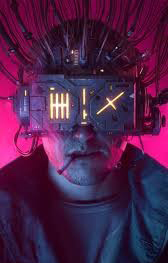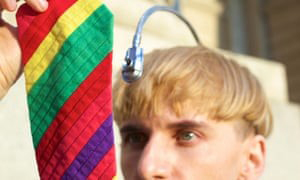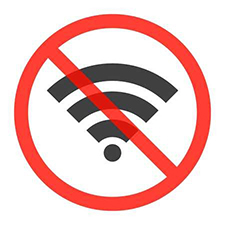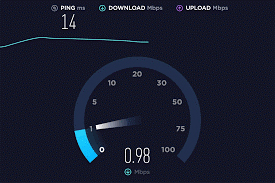
Dr Chris Cameron
Behavioural Scientist
We have to social distance, wear face masks, work from home in little silos and avoid the social interaction our species naturally craves. Behavioural Scientist Dr Chris Cameron examines our ‘new normal’ existence of hermit, internet-linked working and considers whether this is the next phase of human evolution – when the human becomes transhuman – or has it already started to happen?
Transhumanism – A transhuman is a being that resembles a human in most respects, but who has powers and abilities beyond those of standard humans, similar to cyborgs and biohackers. Today, transhumanism is less science fiction than science fact.
Connection on – Are we transhuman yet?
Connection off
With one eye open and one closed, I pad across the kitchen floor toward the bathroom. Its three in the morning and I don’t put on the light in case it wakes me up properly. I don’t need to, my room is illuminated well enough by the blue and green glow of everything I have on charge for another day online, connected to the world via the internet rather than those dangerous face-to-face interactions we are told to avoid. But then, a particular light catches my eye and a sense of dread descends. Red light, warning and worse, it tells me I have no internet connection.
Any notion of a swift return to my still warm bed is gone. In my head an urgent, disturbing voice tells me this is an emergency I must deal with right now. I sit worried for a moment on a cold chair, staring, almost willing it to change to a welcome green light, but it doesn’t. A rummage through a drawer reveals the inevitable quick start guide and I begin to work frantically to get back online. My problem is, thankfully, quickly resolved and my connection is restored.
Connection on
Relieved, I’m back online, reconnected to the outside world. Sleep is not now an option. I check the connection quickly; my internet speeds are low. Like 13 million others, I have become ever more reliant on the video communication tools like Zoom and Teams and soon I’ll need it, for meetings for work and a call to my family. My anxiety rises again. Will it work?
Even the steady glow of the green light doesn’t reassure me all is well. My mind drifts on, in search for some relief as it reaches for the reasons for my discomfort. I start to consider, from a social sciences point of view, how we humans today are once products of our evolved psychology and encultured, and how the internet we rely on so much these days impacts on both.
Connection off – Am I just being human?
Evolutionary psychology tells us we are evolved beings who carry with us the baggage of our evolutionary past. To survive, we seek safety in positive social affiliations and make very powerful social bonds for ourselves, forming social groups like families and friendship networks, with strict cultural rules and values. The ‘old normal’ way of maintaining these bonds was through taken-for-granted routines of face-to-face interaction (F2F). Contained within these are a set of learned behaviours that we call ‘social releasers’, because they are intentionally deployed to release a specific, positive response from the observer.
Many of the most important ones are non-verbal and here we often rely on seeing a person’s face. A quick example – the smile. As a social releaser, it is intended as reciprocal. We smile and that should if all is well, ‘release’ a smile from the observer. If it doesn’t, we become anxious and often seek to alleviate that unpleasant emotion by deploying another, this time verbal social releaser, by asking ‘Are you OK?’. As you can imagine, these verbal/nonverbal exchanges can go on for a while. In fact, they go on for the lifetime of a relationship. We are supremely attuned to this process, reading every look, every inflection and even silence can be very significant here.
Now, switch off the connection through F2F interaction and many of these signals are lost to us. It’s a kind of information poverty. Even if we are digital natives, we are outside our environment of evolutionary adaption. We all have a brain evolved to operate F2F and engage in social interaction with all its richness. Our evolutionary inheritance and our culture just don’t work well together anymore. So, for example, without the F2F smile we create a virtual one, along with a series of others that we may call ‘virtual releasers’.
Just think of your response to this smile. As a virtual releaser, it may well make us smile. Now try this one.
Still smiling? Beginning to feel anxious? That’s how releasers work, F2F or virtual. We are hard wired to use them – and without them our interactions lose meaning. We can thus become unpleasantly anxious as information poverty denies us confirmation of positive social interactions. This is where connections like Zoom and Teams come to the fore – we can see faces – but only if we can connect socially and these days that means a journey into cyberspace. The F2F connection must be on. It is an essential part of what makes us the humans that we are.
Connection on – Are humans evolving differently?
Connection on. It has been suggested in the media that ‘Lockdown may leave a lasting digital legacy. Coronavirus has radically changed the way we live, work and communicate online, with millions of people using online video services for the first time’.

This may well be true and long term, we may have to physically adapt, evolve to cope with life in a new digital era. But evolution is ever so slow and Richard Dawkins argues we now ‘evolve’ differently:
‘It is still in its infancy, still drifting clumsily about in its primeval soup, but already it is achieving evolutionary change at a rate that leaves the old gene panting far behind. That ‘soup’ is human culture’.
Of course, one essential part of that emerging culture (is there any other kind?) is our use of the internet and the new media. Marshall McLuhan added to our understanding of evolution via the media, describing such media as ‘any technology that… creates extensions of the human body and senses … we become what we behold. We shape our tools and then our tools shape us … we become a receiver and a transmitter and by communicating with others we ‘extend’ ourselves in order to communicate and interact’. Connection on. So, aspects of our culture like the online environment aren’t just something we create, they are also something that happens to us. How we connect has an effect on our nature. In short, the internet is an extension of the mind.
Now we can begin see why even our digital natives struggle with social media. Young women are made anxious by online social comparison fuelled by TicTok, or young men glued to video games like Fortnite as they compete through their avatars, all seeking the safety of positive social affiliations and comparisons online.

William Gibson’s sci-fi writings focused on the effects of technology. Well before internet went ‘public’ in 1990, he published the novel Neuromancer where he explores the unintended consequences of the internet. One of these is connecting the mind through implanted technology within the body to new emerging machine intelligence and global information networks. As he did so, he coined the new but now very familiar phrase, ‘cyberspace’. Now, cyberspace and the internet are commonly equated together, but in Gibson’s analysis, cyberspace becomes a space where, in McLuhan’s terms, the internet truly becomes an extension of the mind.

But wait, that’s all science fiction. We still control our internet experiences, don’t we? But then, we need to connect to satisfy our evolved psychology – we just don’t do it directly right now.
Connection always on – Are we transhuman yet?
Transhumanism is a biotechnological state of becoming a human/technological hybrid, a cyborg whose human capabilities are extended by technoscientific means. If that is beginning to sound familiar, it is because cyborgs are amongst us already, in films and on television and also in real life. Biohackers who modify or augment their body with technology have been a fringe community for years, but the trend for installing into a microchip the body has accelerated. People are using their implants to unlock doors, start cars and interact with mobile phones. This, say biohackers, is just the beginning.

Neil Harbisson is a colour-blind artist who, due to his implant, can experience colour as sound. That’s remarkable in itself, but he can hear colours in the infrared and ultraviolet spectrum, far beyond our normal perception. He says ‘red is a serene colour. Violet, though, is savage to my ears’.
Now I would want to argue a transhuman future is inevitable, for two reasons. Firstly, its already begun in earnest, not just as a bioethical stance taken by people like Nick Bostrom, but in commercial applications. Transhumanism is a huge commercial opportunity in a world where opportunity is becoming scarce. For example, from the designers of the now familiar and much copied Fitbit comes Project UnderSkin, which would see implanted devices sending near-field communication signals to perform a variety of functions. Their view is that ‘Implants are already happening, UnderSkin is our vision of what we realistically think can be achieved. Most likely we will all end our life in some partial cyborg state, so it is about time designers start dealing with the interaction with things inside us’.
More radically and closer to our common conception of the cyborg, Elon Musk’s company Neuralink recently revealed a neurosurgical robot which can embed ‘data threads’, much thinner than a human hair, directly into the brain.

So far, the threads have only been tested in animals, but ultimately the aim is to achieve a symbiosis with artificial intelligence (AI) so that humans are not left behind as AI systems outpace human intelligence. Judging by Musk’s other technological successes in commercialised satellites and space flight, this is something to be taken very seriously indeed. Perhaps our rather frightening future is to be permanently connected to a collective online consciousness. No more connections off.
A second driver of transhumanism may well be due to future climate and environmental change. In an envisioned future, following a climatic apocalypse, Paulo Bacigalupi envisions a world where the transhuman ‘Windup’ is a human reconfigured to survive.

Here the transhuman logic is made clear:
‘We should all be windups now. It’s easier to build an (impervious) person than to protect an earlier version of the human creature. A generation from now, we could be well-suited to our new environment. Your children could be the beneficiaries. Yet you people refuse to adapt. You cling to some idea of a humanity that evolved in concert with your environment over millennia, and which you now, perversely, refuse to remain in lockstep with.”
The price for survival is no more connections off. The Windup Girl makes this clear ‘the men who designed me, they make me do things I cannot control. As if their hands are inside me. Like a puppet, yes?’ So, our future may well be transhuman out of necessity, and our connection to the internet permanently on. Are we transhuman yet? The debate goes on, but for many, our journey has already begun.”
Human Behaviour
Browse all our blogs related to Human Behaviour.




